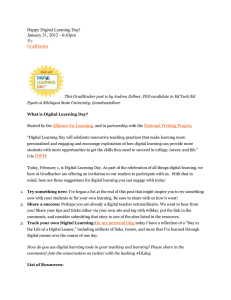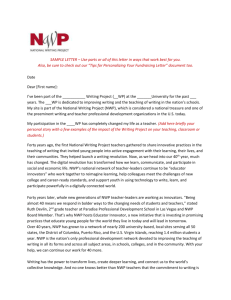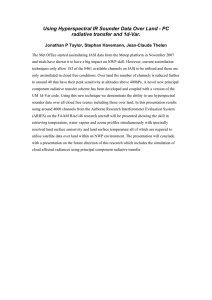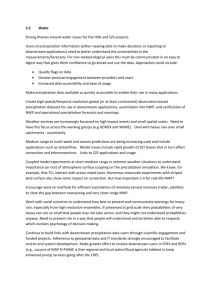Data assimilation and Numerical Weather Prediction
advertisement
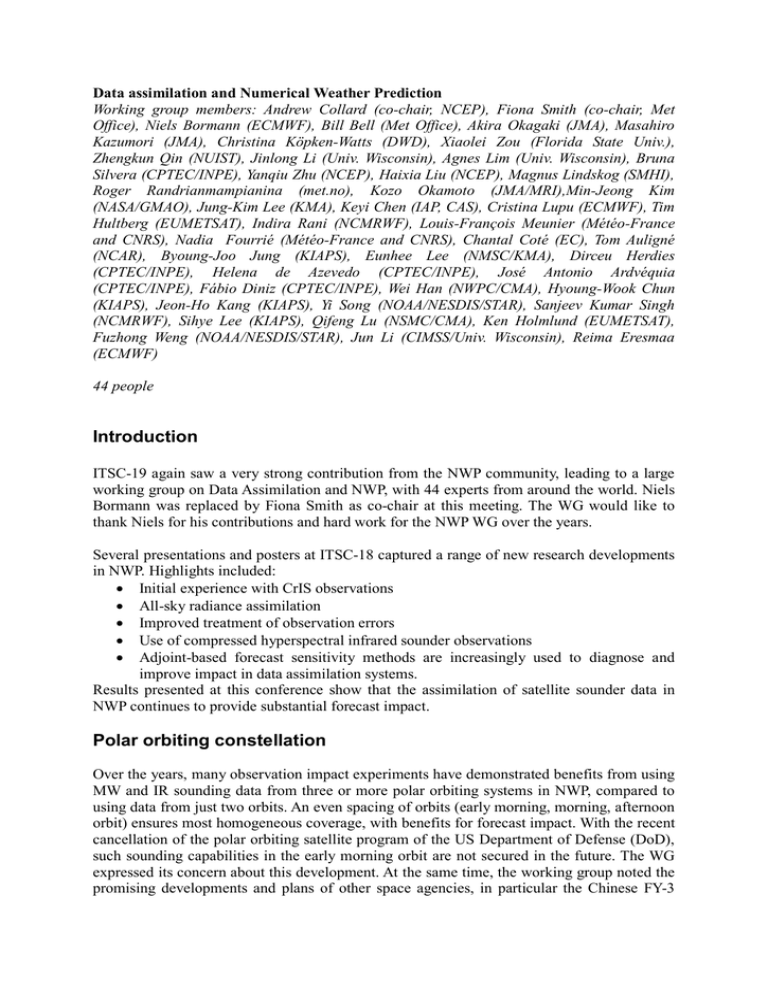
Data assimilation and Numerical Weather Prediction Working group members: Andrew Collard (co-chair, NCEP), Fiona Smith (co-chair, Met Office), Niels Bormann (ECMWF), Bill Bell (Met Office), Akira Okagaki (JMA), Masahiro Kazumori (JMA), Christina Köpken-Watts (DWD), Xiaolei Zou (Florida State Univ.), Zhengkun Qin (NUIST), Jinlong Li (Univ. Wisconsin), Agnes Lim (Univ. Wisconsin), Bruna Silvera (CPTEC/INPE), Yanqiu Zhu (NCEP), Haixia Liu (NCEP), Magnus Lindskog (SMHI), Roger Randrianmampianina (met.no), Kozo Okamoto (JMA/MRI),Min-Jeong Kim (NASA/GMAO), Jung-Kim Lee (KMA), Keyi Chen (IAP, CAS), Cristina Lupu (ECMWF), Tim Hultberg (EUMETSAT), Indira Rani (NCMRWF), Louis-François Meunier (Météo-France and CNRS), Nadia Fourrié (Météo-France and CNRS), Chantal Coté (EC), Tom Auligné (NCAR), Byoung-Joo Jung (KIAPS), Eunhee Lee (NMSC/KMA), Dirceu Herdies (CPTEC/INPE), Helena de Azevedo (CPTEC/INPE), José Antonio Ardvéquia (CPTEC/INPE), Fábio Diniz (CPTEC/INPE), Wei Han (NWPC/CMA), Hyoung-Wook Chun (KIAPS), Jeon-Ho Kang (KIAPS), Yi Song (NOAA/NESDIS/STAR), Sanjeev Kumar Singh (NCMRWF), Sihye Lee (KIAPS), Qifeng Lu (NSMC/CMA), Ken Holmlund (EUMETSAT), Fuzhong Weng (NOAA/NESDIS/STAR), Jun Li (CIMSS/Univ. Wisconsin), Reima Eresmaa (ECMWF) 44 people Introduction ITSC-19 again saw a very strong contribution from the NWP community, leading to a large working group on Data Assimilation and NWP, with 44 experts from around the world. Niels Bormann was replaced by Fiona Smith as co-chair at this meeting. The WG would like to thank Niels for his contributions and hard work for the NWP WG over the years. Several presentations and posters at ITSC-18 captured a range of new research developments in NWP. Highlights included: • Initial experience with CrIS observations • All-sky radiance assimilation • Improved treatment of observation errors • Use of compressed hyperspectral infrared sounder observations • Adjoint-based forecast sensitivity methods are increasingly used to diagnose and improve impact in data assimilation systems. Results presented at this conference show that the assimilation of satellite sounder data in NWP continues to provide substantial forecast impact. Polar orbiting constellation Over the years, many observation impact experiments have demonstrated benefits from using MW and IR sounding data from three or more polar orbiting systems in NWP, compared to using data from just two orbits. An even spacing of orbits (early morning, morning, afternoon orbit) ensures most homogeneous coverage, with benefits for forecast impact. With the recent cancellation of the polar orbiting satellite program of the US Department of Defense (DoD), such sounding capabilities in the early morning orbit are not secured in the future. The WG expressed its concern about this development. At the same time, the working group noted the promising developments and plans of other space agencies, in particular the Chinese FY-3 series, for which instruments from the first experimental satellites show encouraging data quality and availability. The WG sees potential in an optimized coordination between space agencies in this respect, and therefore strongly recommends international cooperation to ensure a better harmonization of orbits. Recommendation DA/NWP-1 to all relevant space agencies: The constellation of at least three orbits (early morning, morning, and afternoon), each with full sounding capabilities (IR and MW), should be maintained. The overpass times of operational satellites with sounding capability (IR and MW) should be coordinated between agencies to maximize coverage (including, e.g., China, India). The group would like to recognise that good work has been done in support of this recommendation already since ITSC-18. However, whilst SSMI/S is recongised as an instrument that provides alternative sounding capability, the launch of F20 is still in doubt. F20 would help with gap mitigation, and the WG recommends that F20 should be flown. Recommendation DA/NWP-2 to the Defense Meteorological Satellite Program: In support of maintaining a robust global satellite observing system, SSMI/S on F20 should be flown, preferably in an early morning orbit. Action DA/NWP-1 on ITSC Co-chairs: To bring these recommendations to the attention of CGMS. Cal/val of future instruments At the previous conference, there was much discussion on the inadequacies of the distribution of test data prior to launch, and of real data during Suomi NPP Cal/Val. Although these issues were not discussed at the working group during this meeting, the group felt that the issue was of such importance that the following recommendations should be repeated to improve the situation for future systems. Recommendation DA/NWP-3 to Space Agencies: New operational data dissemination infrastructure should be tested at an early stage (well before launch) with simulated data. Recommendation DA/NWP-4 to Space Agencies: There should be open access to new satellite data for all NWP centres to help with calibration and validation. Noise estimates in BUFR for microwave sounder data At ITSC-18, the WG discussed plans by EUMETSAT to disseminate instrument NEdT estimates in the BUFR level 1c products for METOP AMSU-A/MHS, information that is also now available for ATMS. At this meeting, the WG noted that this strategy is not being pursued globally, and that there is no standardized procedure for including instrument noise in BUFR across data providers. Recommendation DA/NWP-5 to Data Providers: Agree standardized procedure for inclusion of NEdT estimates within BUFR for microwave data. The WG also retains the following recommendation: Recommendation DA/NWP-6 to Space Agencies and data providers: When designing new or modified BUFR formats, please circulate drafts to the NWP community via the NWP Working Group for feedback, prior to submission to WMO. Data dissemination for hyperspectral infrared sounders It was noted that Meteo-France have produced a new set of channels for IASI to aid assimilation of cloudy radiances (of which the currently disseminated 366 channels are a subset), that could replace the current channel set distributed by GTS. In order to allow potential users to evaluate this dataset, the following actions were recorded: Action DA/NWP-2: Meteo-France to circulate the 500 channel set for cloudy radiance analysis to WG so that GTS users can evaluate proposed new channels. Action DA/NWP-3: Working group members to evaluate and provide feedback to Meteo-France before the beginning of September 2014. Data compression for dissemination of hyperspectral sounder data For future hyperspectral sounders (particularly geostationary imagers such as MTG-IRS) it will be challenging to losslessly disseminate all data. The working group discussed the possibility for a two-stream dissemination approach, where a low data volume stream suitable for operational assimilation would be provided with high reliability, and timeliness, combined with a lossless full resolution dataset (which can be used for research purposes) with reduced reliability and timeliness constraints. Action DA/NWP-4: Data Providers to consider whether this approach is a viable method for data dissemination for future systems. Action DA/NWP-5: NWP Centres to give feedback to data providers on this course of action. The working group appreciates that the optimal approach for production of a low volume datastream may require spectral compression through principal component analysis where a small amount of information is lost with the discarded PCs. If this is the case the working group strongly recommends that a very conservative approach is followed and does not rely on studies (theoretical or otherwise) that indicate that the information can be retained with only a small number principal components. Recommendation DA/NWP-7 to space agencies: If PC compression is used to disseminate hyperspectral IR observations, a conservative approach should be taken in order to mitigate information loss (e.g., by retaining as many principal components as possible). There was discussion on the effect of long term changes in the instrument performance and the atmospheric state (e.g., increasing CO 2 ) on the principal components being employed, but the group agreed there was no evidence at present that this would affect operational NWP, as this can be accounted for by updates to the PC basis vectors. However, changes in the basis vectors would require updates to the data files required for reading the compressed data. Recommendation DA/NWP-8 to data providers and NWP users: A mutually acceptable update strategy should be devised and documented for the dissemination of PC products. Action DA/NWP-6 on EUMETSAT: Circulate proposal on update strategy for IASI PC basis vectors to the working group, considering the length of notice period. Action DA/NWP-7 on WG: Provide feedback on the above proposal. Data compression for assimilation of hyperspectral sounder data If hyperspectral infrared sounder data are disseminated as a set of principal component amplitudes, the data could be assimilated at the NWP centres as either reconstructed radiances or as PC scores. Several talks and posters at this conference discussed the use of compressed observations, but some questions remain as to how this is best achieved. Action DA/NWP-8: NWP Centres to evaluate feasibility of assimilating observations disseminated via a PC-compressed datastream, including the use of cloudy radiances and communicate experiences to relevant data providers. Use of unapodised vs apodised radiances for hyperspectral IR sounders As at ITSC-18, it was noted that applying an apodisation function to resulted in an attenuation of the amplitude of the resonance in the corresponds to the vibrational line structure in the 15μm CO 2 band. unapodised radiances is equivalent to the use of apodised radiances with Band 1 CrIS data interferogram that Whilst the use of a correctly defined instrument noise covariance matrix, it may be easier in practice to test assimilation of unapodised radiances than to attempt to modify R matrices to reflect the correlations introduced through apodisation. NOAA/NESDIS can provided unapodised test datasets in BUFR. However, RTTOV and CRTM do not currently have the capability to model unapodised radiances. Action DA/NWP-9: Fuzhong Weng to produce test dataset of one month of unapodised radiances so that they can be evaluated. Action DA/NWP-10: Users to consider carrying out studies to evaluate the use of unapodised radiances, noting that significant RT development may be required to do this. WG support to NWP community The ITSC NWP WG is recognized as an ideal forum to exchange information and inform/update NWP users about new developments, aided by Wiki-pages and a dedicated email list. Survey For several meetings, the survey on the use of ATOVS data has been capturing the broad developments in the assimilation of sounder data in NWP. Ahead of this meeting, hyperspectral IR data were included in the survey, and the latest results are to be posted on the NWP WG web pages. Also, NWP centres were encouraged to share more detailed information on channel selection and observation error usage as part of this survey, and four centres provided such information, and further contributions are encouraged. Action DA/NWP-11 on NWP centres: Continue to provide information on instrument channels assimilated and their observation error for inclusion on the NWP Working Group pages. Updates should be provided as soon as possible after changes in data usage, but at least before every conference. NWP WG web-site and email list Several other activities were started at the last ITSC meeting to further foster information exchange, for instance in the area of regional data assimilation, where issues such as bias correction and background error specification may require solutions that differ from the practice for global systems. A website dedicated to this is now available (see https://groups.ssec.wisc.edu/groups/itwg/nwp/regional_data_assimilation). Further input is required to make the page a useful repository. Also, the NWP WG email list could be used more effectively, and its increased use is encouraged, for instance for questions regarding data usage or to alert the community of data problems. Action DA/NWP-12 on NWP working group: Review NWP working group website and send comments and additions to the working group co-chairs, and for regional data assimilation to Roger Randriamampianina (rogerr@met.no). Action DA/NWP-13 to NWP WG members to use the NWP WG mailing list for questions or to alert other centres to data problems. At ITSC-17, an activity was started to collect evidence from existing Radio Frequency Interference (RFI) or research into potential impacts of RFI in NWP systems. A website has been set up for this task (https://groups.ssec.wisc.edu/groups/itwg/nwp/rfi_and_nwp), including examples for Windsat, SMOS, and AMSR-E. We need to be able to document instances of RFI so that evidence can be presented to the relevant national authorities who may be able to remove offending illegal transmissions. Action DA/NWP-14 on NWP WG members: Send evidence of RFI to working group chairs for inclusion on the NWP WG RFI web page. SSMI/S Action DA/NWP-15 on NWP WG co-chairs: Confirm SSMI/S QC flags with NRL and circulate a summary to the working group. Bias Correction The group discussed bias correction of sounding data. In particular there is feedback between QC and bias correction, but it is not always clear how to deal with this, and how to spin up coefficients (e.g. should QC be relaxed during spin-up phase). These issues are particularly relevant for surface-sensitive channels and cloud. At the previous ITSC, an intercomparison exercise was proposed, but little progress had been made by this meeting. The group remains unclear on what metrics to use to compare biases, as centres use different methods and predictors. As a first step, it would be instructive for centres to share information on their bias correction schemes. Action DA/NWP-16 on working group members: Send details of bias correction schemes in use, including information on: scheme, predictors, method used to spin up (e.g. relax QC), whether there are any particular features relevant to limited area modes, and whether they are interested in taking part in an intercomparison. Information to be provided by end of July 2014 Action DA/NWP-17 on Roger Randriamampianina. To consider the results of this bias correction survey in conjunction with the NWP usage tables and by end of September 2014 to circulate details of exactly what data to send for a quantitative intercomparison. New work at this ITSC evaluated the use of radiometric uncertainty to constrain bias corrections. However, the information required to do this for all instruments may not be available. Action DA/NWP-18 on Wei Han: To evaluate whether the information on the RT group website is sufficient to provide radiometric uncertainty info needed to evaluate biases. Updated channel characteristics NWP systems or Simultaneous Nadir Overpass (SNO)-methods have been used to revise channel characteristics such as central pass-band frequencies for microwave instruments or spectral response functions for IR sounders. The group noted that it would be useful to collect this information at a central location, as such updates have been shown to reduce some airmass-dependent biases and therefore aid the assimilation of the affected data. The channel characteristics web-page of the RT WG seems a logical place for this, and Paul van Delst agreed to include such information. Action DA/NWP-19 on NWP WG members: If you have estimates of revised channel characteristics resulting from post-launch diagnostics, please email these to Paul van Delst (paul.vandelst@noaa.gov). Impact of CrIS in NWP CrIS data has now been available for around 18 months and is agreed to be of very good quality, but NWP centres seem to be struggling to demonstrate much impact. The group discussed ways in which results and information could be exchanged more rapidly to encourage faster adoption of useful techniques to get more benefit. It was decided that a regular teleconference between those actively working on assimilation may be a useful way to proceed. Action DA/NWP-20 on WG members: Express interest in ~6 monthly telecon and forward information regarding current status of CrIS assimilation to Bill Bell (william.bell@metoffice.gov.uk) by end of April 2014. Action DA/NWP-21 on Bill Bell: To organise through NWP working group a ~6 monthly telecon to update on progress and any new findings regarding assimilation of CrIS. Striping on ATMS: NESDIS would like ATMS radiance products with striping effects mitigated to be tested by NWP centres. NESDIS are willing to provide these data through BUFR for an initial one month period, which may be extended to allow full evaluation of forecast impact. Action DA/NWP-22: Fuzhong Weng to provide at least one month of reprocessed destriped ATMS BUFR data, along with documentation on methods used, and to advertise availability through WG mailing list. Recommendation DA/NWP-9: Centres to use the data provided by Fuzhong to assess impact of striping and to provide feedback to NESDIS. Surface Properties The group noted that the surface properties subgroup did not meet at this conference. Action DA/NWP-23: WG co-chairs to circulate a summary on the activities of the surface subgroup to working group members. Cloudy radiance assimilation The group noted that progress had been made in this area since the last conference. There was, however, the perception that for certain scenarios, RT accuracy still needs to be improved, for example via the inclusion of the discrete dipole approximation (DDA), and by taking explicit account of the third stokes parameter in heavy precipitation events. Recommendation DA/NWP-10: RT model developers to ensure that DDA is used for precipitating profiles and to consider what to do in heavy rainfall areas. Encourage investigation of treatment options for frozen hydrometeors in the forward operator. Microwave emissivity It was noted at the conference that for accurate modeling of microwave sea surface emissivity, satellite azimuth information is required to allow treatment of wind direction. Recommendation: DA/NWP-11: Data providers to include azimuthal angle included in BUFR for present and future centres Recommendation DA/NWP-12: RT Models to include treatment of wind direction in microwave emissivity models User Notifications There is some confusion in the working group on how to receive user notifications from data centres regarding instrument problems, and changes to data supply. The NWP WG web pages contain contact information for the agencies and some details of notification services. Recommendation DA/NWP-13: All agencies to provide user notification services that people can sign up to receive: Instrument alerts including rough recovery schedules, and advance notification of changes to data supplies Recommendation DA/NWP-14: WG members to sign up to these notifications and feed back any issues to data providers. Investment to fully realise potential of new satellites in operational use New satellite programs can cost hundreds of millions of Euros and yet it can take many years to learn to properly exploit the data in numerical weather prediction. Additional investment in operational NWP (which while still expensive is only a few percent of the satellites themselves) therefore represents an efficient path for improving the cost/benefit ratio for satellite observations. This investment should focus on improved computational resources (allowing more sophisticated models to be run and more resources for research); development of new assimilation techniques (many centres are still not running 4DVar thereby reducing the impact of observations with high temporal frequency) and improvement to the forecast models, as well as methods focussed on the particular observations themselves. Investment in operational NWP is preferred as research conducted in this paradigm from the start is more easily transferred to operational status. It is also noted that the larger the number of operational centres able to conduct cutting-edge research, the more likely that break-throughs will be made in the use of satellite data. Recommendation DA/NWP-15 to funding bodies of NWP centres and space agencies: Consider, as part of the cost of satellite programs, providing computational and personnel resources targeted at operational NWP centres to optimise the public’s return on investment from these expensive measurement systems.
